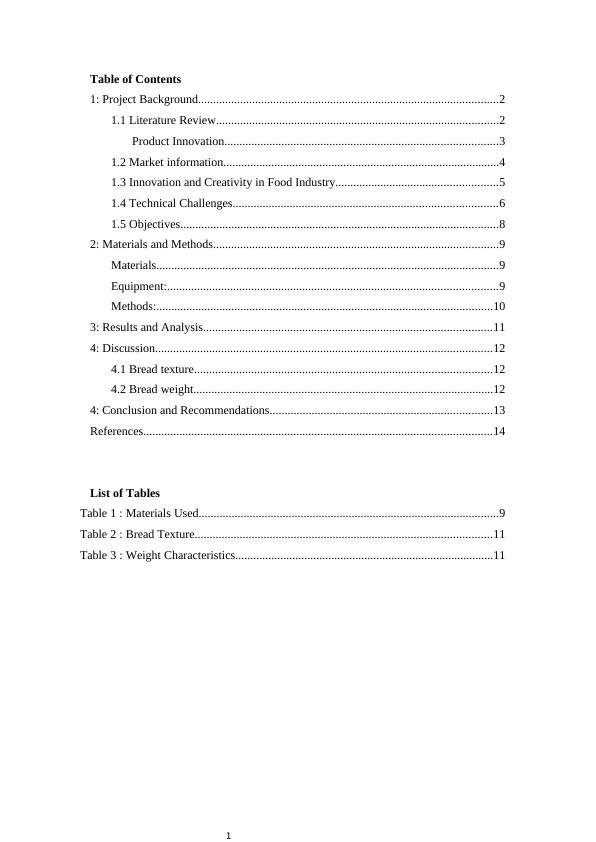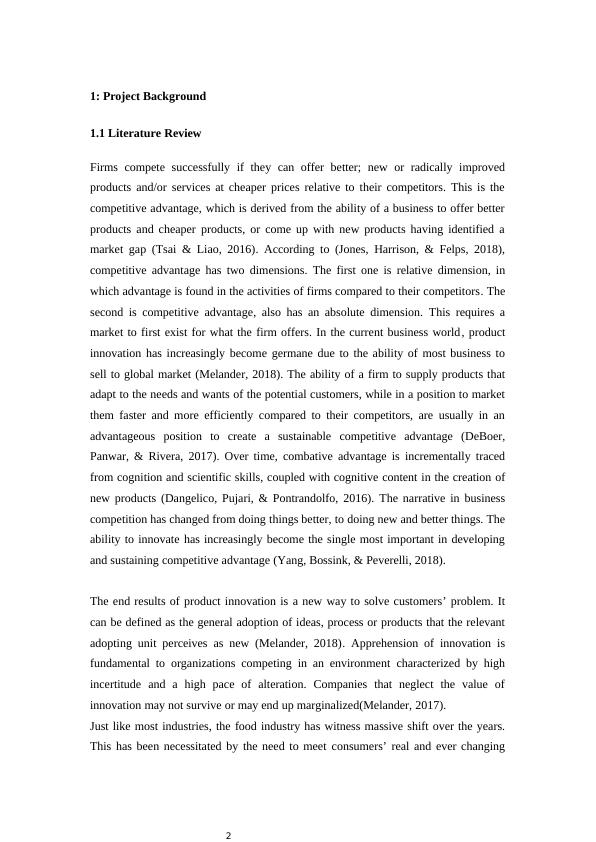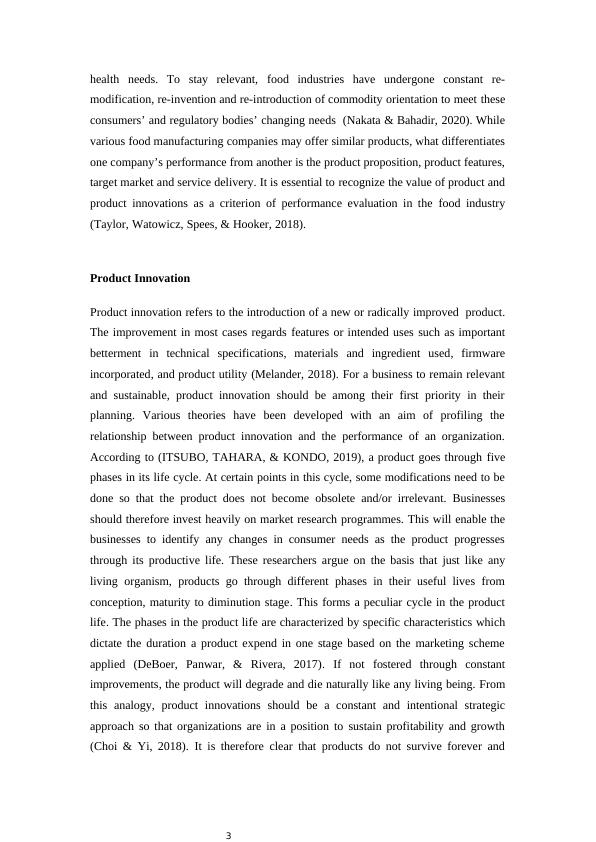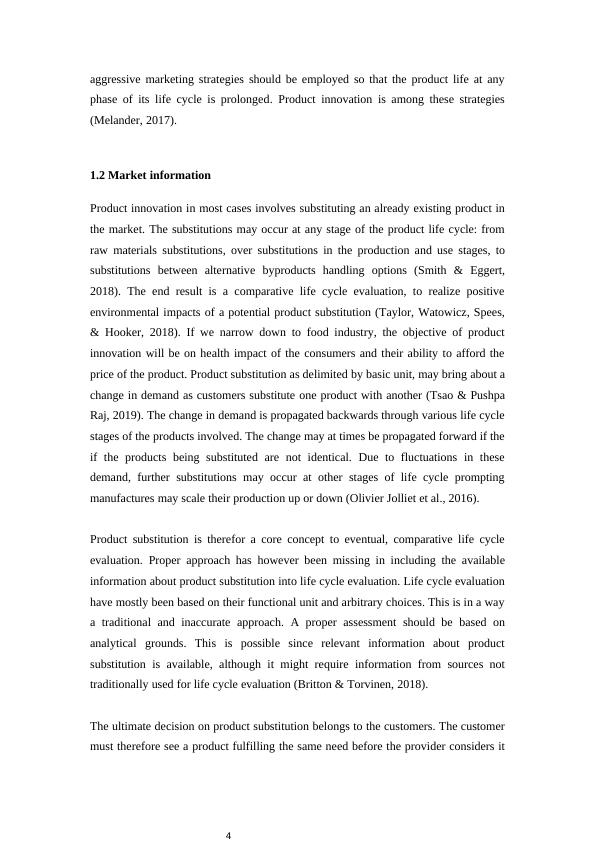Project Background Sample Assignment
Mark scheme for a technical report on the incorporation of novel dietary fibre into foods
15 Pages4231 Words59 Views
Added on 2022-08-31
Project Background Sample Assignment
Mark scheme for a technical report on the incorporation of novel dietary fibre into foods
Added on 2022-08-31
ShareRelated Documents
1
Table of Contents
1: Project Background....................................................................................................2
1.1 Literature Review..............................................................................................2
Product Innovation...........................................................................................3
1.2 Market information............................................................................................4
1.3 Innovation and Creativity in Food Industry......................................................5
1.4 Technical Challenges........................................................................................6
1.5 Objectives..........................................................................................................8
2: Materials and Methods...............................................................................................9
Materials..................................................................................................................9
Equipment:..............................................................................................................9
Methods:................................................................................................................10
3: Results and Analysis................................................................................................11
4: Discussion................................................................................................................12
4.1 Bread texture...................................................................................................12
4.2 Bread weight....................................................................................................12
4: Conclusion and Recommendations..........................................................................13
References....................................................................................................................14
List of Tables
Table 1 : Materials Used....................................................................................................9
Table 2 : Bread Texture...................................................................................................11
Table 3 : Weight Characteristics......................................................................................11
Table of Contents
1: Project Background....................................................................................................2
1.1 Literature Review..............................................................................................2
Product Innovation...........................................................................................3
1.2 Market information............................................................................................4
1.3 Innovation and Creativity in Food Industry......................................................5
1.4 Technical Challenges........................................................................................6
1.5 Objectives..........................................................................................................8
2: Materials and Methods...............................................................................................9
Materials..................................................................................................................9
Equipment:..............................................................................................................9
Methods:................................................................................................................10
3: Results and Analysis................................................................................................11
4: Discussion................................................................................................................12
4.1 Bread texture...................................................................................................12
4.2 Bread weight....................................................................................................12
4: Conclusion and Recommendations..........................................................................13
References....................................................................................................................14
List of Tables
Table 1 : Materials Used....................................................................................................9
Table 2 : Bread Texture...................................................................................................11
Table 3 : Weight Characteristics......................................................................................11

2
1: Project Background
1.1 Literature Review
Firms compete successfully if they can offer better; new or radically improved
products and/or services at cheaper prices relative to their competitors. This is the
competitive advantage, which is derived from the ability of a business to offer better
products and cheaper products, or come up with new products having identified a
market gap (Tsai & Liao, 2016). According to (Jones, Harrison, & Felps, 2018),
competitive advantage has two dimensions. The first one is relative dimension, in
which advantage is found in the activities of firms compared to their competitors. The
second is competitive advantage, also has an absolute dimension. This requires a
market to first exist for what the firm offers. In the current business world, product
innovation has increasingly become germane due to the ability of most business to
sell to global market (Melander, 2018). The ability of a firm to supply products that
adapt to the needs and wants of the potential customers, while in a position to market
them faster and more efficiently compared to their competitors, are usually in an
advantageous position to create a sustainable competitive advantage (DeBoer,
Panwar, & Rivera, 2017). Over time, combative advantage is incrementally traced
from cognition and scientific skills, coupled with cognitive content in the creation of
new products (Dangelico, Pujari, & Pontrandolfo, 2016). The narrative in business
competition has changed from doing things better, to doing new and better things. The
ability to innovate has increasingly become the single most important in developing
and sustaining competitive advantage (Yang, Bossink, & Peverelli, 2018).
The end results of product innovation is a new way to solve customers’ problem. It
can be defined as the general adoption of ideas, process or products that the relevant
adopting unit perceives as new (Melander, 2018). Apprehension of innovation is
fundamental to organizations competing in an environment characterized by high
incertitude and a high pace of alteration. Companies that neglect the value of
innovation may not survive or may end up marginalized(Melander, 2017).
Just like most industries, the food industry has witness massive shift over the years.
This has been necessitated by the need to meet consumers’ real and ever changing
1: Project Background
1.1 Literature Review
Firms compete successfully if they can offer better; new or radically improved
products and/or services at cheaper prices relative to their competitors. This is the
competitive advantage, which is derived from the ability of a business to offer better
products and cheaper products, or come up with new products having identified a
market gap (Tsai & Liao, 2016). According to (Jones, Harrison, & Felps, 2018),
competitive advantage has two dimensions. The first one is relative dimension, in
which advantage is found in the activities of firms compared to their competitors. The
second is competitive advantage, also has an absolute dimension. This requires a
market to first exist for what the firm offers. In the current business world, product
innovation has increasingly become germane due to the ability of most business to
sell to global market (Melander, 2018). The ability of a firm to supply products that
adapt to the needs and wants of the potential customers, while in a position to market
them faster and more efficiently compared to their competitors, are usually in an
advantageous position to create a sustainable competitive advantage (DeBoer,
Panwar, & Rivera, 2017). Over time, combative advantage is incrementally traced
from cognition and scientific skills, coupled with cognitive content in the creation of
new products (Dangelico, Pujari, & Pontrandolfo, 2016). The narrative in business
competition has changed from doing things better, to doing new and better things. The
ability to innovate has increasingly become the single most important in developing
and sustaining competitive advantage (Yang, Bossink, & Peverelli, 2018).
The end results of product innovation is a new way to solve customers’ problem. It
can be defined as the general adoption of ideas, process or products that the relevant
adopting unit perceives as new (Melander, 2018). Apprehension of innovation is
fundamental to organizations competing in an environment characterized by high
incertitude and a high pace of alteration. Companies that neglect the value of
innovation may not survive or may end up marginalized(Melander, 2017).
Just like most industries, the food industry has witness massive shift over the years.
This has been necessitated by the need to meet consumers’ real and ever changing

3
health needs. To stay relevant, food industries have undergone constant re-
modification, re-invention and re-introduction of commodity orientation to meet these
consumers’ and regulatory bodies’ changing needs (Nakata & Bahadir, 2020). While
various food manufacturing companies may offer similar products, what differentiates
one company’s performance from another is the product proposition, product features,
target market and service delivery. It is essential to recognize the value of product and
product innovations as a criterion of performance evaluation in the food industry
(Taylor, Watowicz, Spees, & Hooker, 2018).
Product Innovation
Product innovation refers to the introduction of a new or radically improved product.
The improvement in most cases regards features or intended uses such as important
betterment in technical specifications, materials and ingredient used, firmware
incorporated, and product utility (Melander, 2018). For a business to remain relevant
and sustainable, product innovation should be among their first priority in their
planning. Various theories have been developed with an aim of profiling the
relationship between product innovation and the performance of an organization.
According to (ITSUBO, TAHARA, & KONDO, 2019), a product goes through five
phases in its life cycle. At certain points in this cycle, some modifications need to be
done so that the product does not become obsolete and/or irrelevant. Businesses
should therefore invest heavily on market research programmes. This will enable the
businesses to identify any changes in consumer needs as the product progresses
through its productive life. These researchers argue on the basis that just like any
living organism, products go through different phases in their useful lives from
conception, maturity to diminution stage. This forms a peculiar cycle in the product
life. The phases in the product life are characterized by specific characteristics which
dictate the duration a product expend in one stage based on the marketing scheme
applied (DeBoer, Panwar, & Rivera, 2017). If not fostered through constant
improvements, the product will degrade and die naturally like any living being. From
this analogy, product innovations should be a constant and intentional strategic
approach so that organizations are in a position to sustain profitability and growth
(Choi & Yi, 2018). It is therefore clear that products do not survive forever and
health needs. To stay relevant, food industries have undergone constant re-
modification, re-invention and re-introduction of commodity orientation to meet these
consumers’ and regulatory bodies’ changing needs (Nakata & Bahadir, 2020). While
various food manufacturing companies may offer similar products, what differentiates
one company’s performance from another is the product proposition, product features,
target market and service delivery. It is essential to recognize the value of product and
product innovations as a criterion of performance evaluation in the food industry
(Taylor, Watowicz, Spees, & Hooker, 2018).
Product Innovation
Product innovation refers to the introduction of a new or radically improved product.
The improvement in most cases regards features or intended uses such as important
betterment in technical specifications, materials and ingredient used, firmware
incorporated, and product utility (Melander, 2018). For a business to remain relevant
and sustainable, product innovation should be among their first priority in their
planning. Various theories have been developed with an aim of profiling the
relationship between product innovation and the performance of an organization.
According to (ITSUBO, TAHARA, & KONDO, 2019), a product goes through five
phases in its life cycle. At certain points in this cycle, some modifications need to be
done so that the product does not become obsolete and/or irrelevant. Businesses
should therefore invest heavily on market research programmes. This will enable the
businesses to identify any changes in consumer needs as the product progresses
through its productive life. These researchers argue on the basis that just like any
living organism, products go through different phases in their useful lives from
conception, maturity to diminution stage. This forms a peculiar cycle in the product
life. The phases in the product life are characterized by specific characteristics which
dictate the duration a product expend in one stage based on the marketing scheme
applied (DeBoer, Panwar, & Rivera, 2017). If not fostered through constant
improvements, the product will degrade and die naturally like any living being. From
this analogy, product innovations should be a constant and intentional strategic
approach so that organizations are in a position to sustain profitability and growth
(Choi & Yi, 2018). It is therefore clear that products do not survive forever and

4
aggressive marketing strategies should be employed so that the product life at any
phase of its life cycle is prolonged. Product innovation is among these strategies
(Melander, 2017).
1.2 Market information
Product innovation in most cases involves substituting an already existing product in
the market. The substitutions may occur at any stage of the product life cycle: from
raw materials substitutions, over substitutions in the production and use stages, to
substitutions between alternative byproducts handling options (Smith & Eggert,
2018). The end result is a comparative life cycle evaluation, to realize positive
environmental impacts of a potential product substitution (Taylor, Watowicz, Spees,
& Hooker, 2018). If we narrow down to food industry, the objective of product
innovation will be on health impact of the consumers and their ability to afford the
price of the product. Product substitution as delimited by basic unit, may bring about a
change in demand as customers substitute one product with another (Tsao & Pushpa
Raj, 2019). The change in demand is propagated backwards through various life cycle
stages of the products involved. The change may at times be propagated forward if the
if the products being substituted are not identical. Due to fluctuations in these
demand, further substitutions may occur at other stages of life cycle prompting
manufactures may scale their production up or down (Olivier Jolliet et al., 2016).
Product substitution is therefor a core concept to eventual, comparative life cycle
evaluation. Proper approach has however been missing in including the available
information about product substitution into life cycle evaluation. Life cycle evaluation
have mostly been based on their functional unit and arbitrary choices. This is in a way
a traditional and inaccurate approach. A proper assessment should be based on
analytical grounds. This is possible since relevant information about product
substitution is available, although it might require information from sources not
traditionally used for life cycle evaluation (Britton & Torvinen, 2018).
The ultimate decision on product substitution belongs to the customers. The customer
must therefore see a product fulfilling the same need before the provider considers it
aggressive marketing strategies should be employed so that the product life at any
phase of its life cycle is prolonged. Product innovation is among these strategies
(Melander, 2017).
1.2 Market information
Product innovation in most cases involves substituting an already existing product in
the market. The substitutions may occur at any stage of the product life cycle: from
raw materials substitutions, over substitutions in the production and use stages, to
substitutions between alternative byproducts handling options (Smith & Eggert,
2018). The end result is a comparative life cycle evaluation, to realize positive
environmental impacts of a potential product substitution (Taylor, Watowicz, Spees,
& Hooker, 2018). If we narrow down to food industry, the objective of product
innovation will be on health impact of the consumers and their ability to afford the
price of the product. Product substitution as delimited by basic unit, may bring about a
change in demand as customers substitute one product with another (Tsao & Pushpa
Raj, 2019). The change in demand is propagated backwards through various life cycle
stages of the products involved. The change may at times be propagated forward if the
if the products being substituted are not identical. Due to fluctuations in these
demand, further substitutions may occur at other stages of life cycle prompting
manufactures may scale their production up or down (Olivier Jolliet et al., 2016).
Product substitution is therefor a core concept to eventual, comparative life cycle
evaluation. Proper approach has however been missing in including the available
information about product substitution into life cycle evaluation. Life cycle evaluation
have mostly been based on their functional unit and arbitrary choices. This is in a way
a traditional and inaccurate approach. A proper assessment should be based on
analytical grounds. This is possible since relevant information about product
substitution is available, although it might require information from sources not
traditionally used for life cycle evaluation (Britton & Torvinen, 2018).
The ultimate decision on product substitution belongs to the customers. The customer
must therefore see a product fulfilling the same need before the provider considers it

End of preview
Want to access all the pages? Upload your documents or become a member.
Related Documents
Global Economic Environment and Marketing - PDFlg...
|11
|3496
|95
Gatorade Supply Chain Analysis: Market Share, Competition, and Potentiallg...
|13
|1381
|446
Business Plan for Bites Healthy Foods Restaurantlg...
|10
|2599
|126
Planning for Growth: Key Considerations, Evaluation of Opportunities, and Funding Sourceslg...
|16
|4789
|73
Exploring Competitive Advantages of Flavoured Banana and Nut Bread by Clinton Street Baking Companylg...
|7
|1302
|98
Investigation into Business Sectorlg...
|10
|2684
|53
